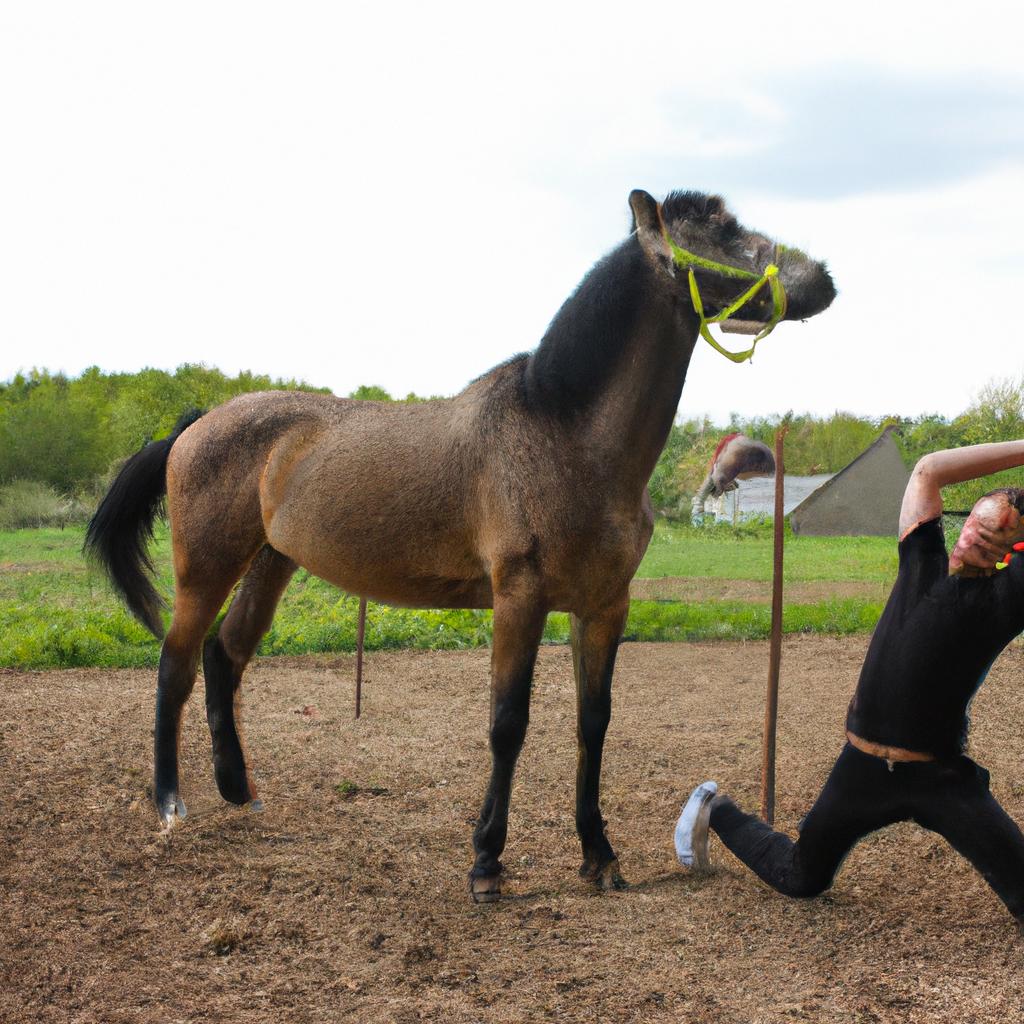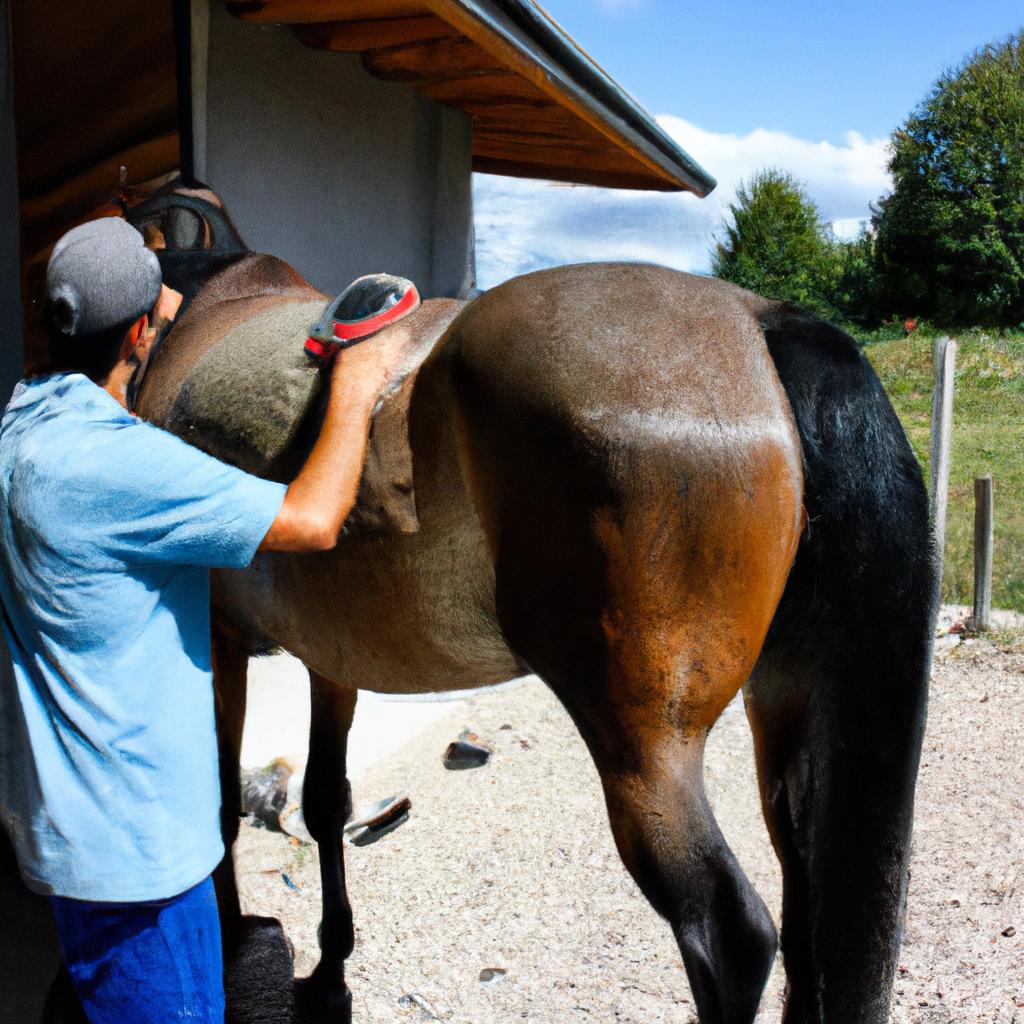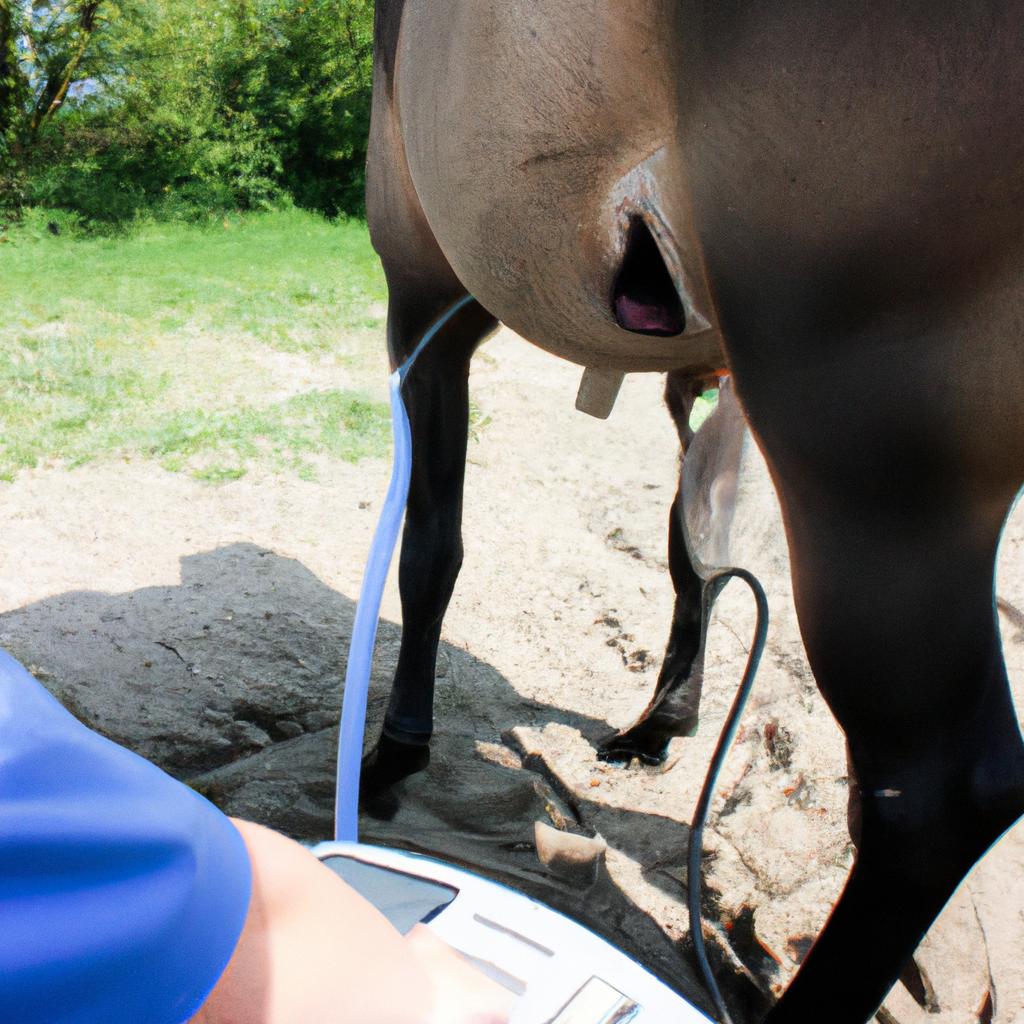Equine chiropractic techniques have gained significant recognition in recent years as a valuable form of alternative therapy for horses. This article aims to explore the diagnostic techniques employed by equine chiropractors, shedding light on their efficacy and potential benefits for equine health. To illustrate the significance of these techniques, consider a hypothetical scenario where a racehorse experiences recurrent lameness issues that conventional veterinary medicine fails to diagnose accurately. Equine chiropractic diagnostic methods could then be utilized to identify musculoskeletal imbalances or misalignments that may be contributing to the horse’s discomfort.
The field of equine chiropractic revolves around identifying and treating subluxations, which are partial dislocations or abnormal movements within the spinal joints. These subluxations can lead to pain and dysfunction not only in the spine but also throughout other body systems. The diagnosis of such subluxations involves various palpation techniques aimed at detecting asymmetries, muscle tension patterns, and restricted joint mobility in horses. By carefully assessing the horse’s posture, range of motion, and response to specific stimuli, an equine chiropractor can pinpoint areas requiring adjustment or manipulation.
In conclusion, understanding the diagnostic techniques used in equine chiropractic is crucial for appreciating its potential contributions towards improving overall horse health.
Understanding the Anatomy of the Horse
Imagine a scenario where a horse experiences difficulty in performing its usual movements, such as galloping or jumping. To better comprehend this situation, it is essential to delve into the intricate anatomy of horses. By understanding their musculoskeletal system and how it functions, we can gain insight into potential issues that may affect their overall performance.
One fundamental aspect to consider is the structure of a horse’s spine. The equine vertebral column consists of seven cervical vertebrae (neck region), eighteen thoracic vertebrae (chest area), six lumbar vertebrae (lower back), five sacral vertebrae (pelvic region), and fifteen coccygeal vertebrae (tailbone). This complex arrangement allows for flexibility while providing stability during various movements. For instance, when a horse jumps over an obstacle, its spinal column must adapt to absorb the impact upon landing.
In addition to the spine, another crucial element is the horse’s skeletal muscles. These muscles play a vital role in maintaining posture and facilitating locomotion. They are responsible for generating power and force needed for movement across different gaits. However, just like any other living organism, horses are susceptible to muscular imbalances or injuries caused by overexertion or inadequate conditioning.
To further illustrate these points visually:
- Horses rely on their efficient biomechanics for optimal performance.
- A well-balanced musculoskeletal system ensures longevity and prevents lameness.
- Muscular imbalances can lead to decreased range of motion and discomfort.
- Regular assessment and treatment help maintain peak athletic ability.
Consider the following table showcasing common signs associated with musculoskeletal issues in horses:
| Signs | Description | Example |
|---|---|---|
| Lameness | Abnormal gait patterns resulting from pain or structural abnormalities | Uneven strides |
| Decreased Performance | Reduced ability to perform at previous levels | Slower race times |
| Stiffness | Difficulty moving smoothly and flexibly | Reluctance to bend |
| Muscle Atrophy | Wasting or loss of muscle mass due to disuse or injury | Sunken appearance |
By gaining a comprehensive understanding of the horse’s anatomy, we can better recognize and address potential musculoskeletal issues. In the subsequent section, we will explore common signs and symptoms that may indicate such problems in horses without abruptly transitioning.
Next Section: Common Signs and Symptoms of Equine Musculoskeletal Issues
Common Signs and Symptoms of Equine Musculoskeletal Issues
Understanding the Anatomy of the Horse is crucial in diagnosing and treating equine musculoskeletal issues. By gaining knowledge about the horse’s intricate anatomy, veterinarians and chiropractors can effectively identify potential problem areas and develop appropriate treatment plans. One example that highlights the importance of this understanding is a case study involving a 10-year-old Thoroughbred racehorse named Lightning.
Lightning had been experiencing decreased performance on the racetrack, with noticeable stiffness and resistance during training sessions. Upon examination, it was discovered that Lightning had developed tension and misalignment in his thoracic vertebrae. This condition was causing discomfort and restricting his range of motion, ultimately affecting his ability to perform at optimal levels.
To address Lightning’s condition, it was necessary to have a comprehensive understanding of equine anatomy. Here are some key points that highlight the complexity of a horse’s musculoskeletal system:
- The vertebral column: Comprised of seven cervical vertebrae (neck), eighteen thoracic vertebrae (with attached ribs), six lumbar vertebrae (lower back), five sacral vertebrae (pelvic region), and fifteen to twenty coccygeal vertebrae (tail).
- Muscles: Horses possess an extensive network of muscles throughout their body, which play a vital role in movement and support.
- Joints: A horse’s joints allow for flexibility and mobility; however, they are susceptible to wear and tear over time.
- Ligaments and tendons: These fibrous connective tissues provide stability to joints as well as facilitate smooth muscle movements.
In order to gain further insight into equine anatomy, diagnostic tools such as radiography, ultrasound imaging, thermal imaging, or computed tomography scans may be utilized. These tools help visualize internal structures and detect any abnormalities or injuries that may not be visible externally.
By comprehending the intricacies of equine anatomy through thorough research and observation, practitioners can effectively diagnose and treat musculoskeletal issues in horses. In the subsequent section, we will delve into The Role of Diagnostic Tools in Equine Chiropractic, exploring how these tools aid in identifying specific problem areas and developing targeted treatment plans.
[Table]| Key Points |
|---|
| 1. A comprehensive understanding of equine anatomy is crucial for diagnosing and treating musculoskeletal issues. |
| 2. The vertebral column, muscles, joints, ligaments, and tendons all play significant roles in a horse’s overall movement and support system. |
| 3. Diagnostic tools such as radiography, ultrasound imaging, thermal imaging, or computed tomography scans help visualize internal structures to identify abnormalities or injuries that may not be visible externally. |
| 4. By utilizing diagnostic tools and having a thorough knowledge of equine anatomy, practitioners can develop targeted treatment plans for their patients’ musculoskeletal problems. |
Understanding the intricacies of equine anatomy allows veterinary professionals to pinpoint problem areas accurately and develop effective treatments for horses experiencing musculoskeletal issues. In the upcoming section on The Role of Diagnostic Tools in Equine Chiropractic, we will explore how these tools assist in identifying specific concerns within horses’ anatomical structure without relying solely on palpation techniques or subjective observations.
The Role of Diagnostic Tools in Equine Chiropractic
Equine Chiropractic Techniques: Diagnostic Techniques for Horses
Common Signs and Symptoms of Equine Musculoskeletal Issues often serve as a starting point for equine chiropractors to identify potential problem areas in horses. However, it is crucial to complement these observations with the use of diagnostic tools that can provide more accurate assessments. By incorporating various techniques into their practice, equine chiropractors can gain valuable insights into the musculoskeletal health of horses, enabling them to devise effective treatment plans tailored to each individual animal.
Let us consider an example to understand how diagnostic tools play a vital role in equine chiropractic care. Imagine a horse named Bella displaying signs of lameness during exercise. While her limp suggests a possible issue with her legs or hooves, additional diagnostic techniques can help pinpoint the exact cause more precisely. Through the utilization of advanced imaging methods such as X-rays or ultrasound, veterinarians and chiropractors can examine the internal structures of Bella’s limbs and assess any abnormalities or injuries that may be contributing to her lameness.
Diagnostic tools used in equine chiropractic encompass a range of modalities designed to evaluate different aspects of a horse’s musculoskeletal system. These include:
- Thermography: This technique uses infrared cameras to detect variations in skin temperature caused by inflammation or injury.
- Gait analysis: By observing a horse’s movement patterns at various speeds, professionals can identify irregularities indicative of underlying issues.
- Flexion tests: These involve applying controlled pressure on specific joints while monitoring the horse’s response, helping reveal joint dysfunction or discomfort.
- Lameness exams: A comprehensive evaluation involving visual assessment, palpation, flexion tests, and sometimes nerve blocks to diagnose lameness causes accurately.
To illustrate further how these techniques contribute to diagnosing equine musculoskeletal problems effectively, let us delve into a hypothetical case study:
Case Study: Evaluation Using Diagnostic Tools
| Symptom | Diagnostic Technique | Findings |
|---|---|---|
| Lameness | Gait analysis | Uneven weight distribution during trotting |
| Decreased Range | Flexion tests | Reluctance and discomfort in hind limb flexion |
| of Motion | ||
| Swelling | Thermography | Increased skin temperature around the joint |
In this case, the gait analysis revealed an uneven weight distribution in Bella’s limbs while trotting, indicating a potential issue that needs further examination. The flexion tests then provided insight into decreased range of motion in her hind limb joints, specifically displaying reluctance and discomfort during flexion. Lastly, thermographic imaging showed increased skin temperature surrounding one particular joint, suggesting inflammation or swelling. Integrating these findings allows equine chiropractors to develop targeted treatment plans to address each specific problem area effectively.
Palpation Techniques for Assessing Horse’s Range of Motion will be explored next as we delve deeper into the diagnostic techniques employed by equine chiropractors. Through palpation, practitioners can gather valuable information about a horse’s musculoskeletal health and identify areas requiring adjustment or therapy.
Palpation Techniques for Assessing Horse’s Range of Motion
Equine chiropractic techniques rely on a variety of diagnostic tools to assess and address issues in horses. One such tool is the use of palpation techniques, which allow practitioners to evaluate the horse’s range of motion and identify areas of tension or discomfort. By understanding how these techniques are used in equine chiropractic, professionals can effectively diagnose and treat musculoskeletal problems in horses.
For example, let us consider a hypothetical case study involving a dressage horse experiencing difficulty with lateral movements. The practitioner begins by using palpation techniques to assess the horse’s range of motion in its hind limbs. Through careful examination, they detect restrictions in the hip joint, leading them to suspect an underlying issue contributing to the horse’s poor performance.
Palpation techniques involve applying subtle pressure and movement to specific anatomical structures, allowing the practitioner to feel for abnormalities or irregularities within the muscles, joints, tendons, and ligaments. This hands-on approach provides valuable insights into the horse’s condition and helps guide treatment decisions.
In equine chiropractic practice, various palpation techniques are employed:
- Trigger point identification: Practitioners locate hypersensitive points within muscle tissue that may cause referred pain or restrict movement.
- Joint assessment: Evaluation of joint mobility aids in identifying any misalignments or subluxations that may be affecting overall function.
- Soft tissue evaluation: Palpating soft tissues surrounding problematic areas helps determine if there are signs of inflammation, swelling, or trigger points.
- Ligamentous assessment: Assessing ligament integrity gives insight into stability and potential sources of pain or dysfunction.
To further illustrate the significance of palpation techniques in equine chiropractic diagnosis, consider Table 1 below:
| Technique | Purpose |
|---|---|
| Trigger Point | Identify pain points |
| Joint Assessment | Evaluate alignment |
| Soft Tissue | Check for inflammation |
| Ligamentous | Assess stability |
Table 1: Palpation Techniques in Equine Chiropractic Diagnosis
By utilizing these palpation techniques, practitioners can gather valuable information about the horse’s condition and determine appropriate treatment plans. The ability to identify areas of concern through hands-on examination aids in addressing musculoskeletal issues effectively.
Transitioning into the subsequent section on “Assessing Posture and Gait Abnormalities in Horses,” it is important to note that understanding a horse’s range of motion is only one aspect of equine chiropractic diagnosis. In order to comprehensively evaluate the horse’s overall function, assessing its posture and gait abnormalities becomes essential. By examining how a horse carries itself and moves, practitioners can gain deeper insights into potential underlying biomechanical problems that may require attention.
Assessing Posture and Gait Abnormalities in Horses
Imagine a scenario where a horse owner notices that their usually graceful Arabian horse, named Luna, is exhibiting unusual posture and gait abnormalities. Luna’s head seems to be tilted slightly to one side, her back appears tense, and she is showing signs of discomfort while moving. In such cases, it becomes crucial for an equine chiropractor to assess the posture and gait abnormalities present in horses.
To effectively evaluate these issues, equine chiropractors employ various diagnostic techniques. One technique involves observing the horse from different angles as they walk or trot. By carefully analyzing the horse’s movement patterns, professionals can detect any irregularities or asymmetries in their gait. Additionally, palpation techniques are used to examine specific areas of tension or misalignment along the spine and other joints.
When assessing posture and gait abnormalities in horses, several key factors need close attention:
- Alignment: Checking if there is symmetry between both sides of the body.
- Range of motion: Assessing how freely the horse moves its limbs without restrictions.
- Flexibility: Examining whether there are any limitations or stiffness in certain areas.
- Stability: Determining if the horse maintains balance during movement.
By utilizing these assessment criteria, equine chiropractors gain valuable insight into identifying postural imbalances and abnormal gaits. Through this comprehensive evaluation process, practitioners develop tailored treatment plans aimed at restoring proper alignment and alleviating any discomfort experienced by horses like Luna.
Table: Common Posture and Gait Abnormalities
| Abnormality | Description |
|---|---|
| Swayback | Excessive curvature of the spine resulting in a dip behind the withers |
| Base Narrow/Stance Close | The distance between the legs when viewed from behind is narrower than normal |
| Paddling Outward | Front hooves swing outward when moving forward instead of staying in a straight line |
| Winged In | Front hooves move inward, crossing over each other when moving forward |
Equine chiropractors play a vital role in identifying and addressing posture and gait abnormalities, as these issues can significantly impact the horse’s overall well-being and performance. By collaborating with veterinary professionals and utilizing diagnostic techniques like palpation and gait analysis, equine chiropractors ensure that horses receive comprehensive care for their musculoskeletal health.
Transitioning into the subsequent section on the importance of collaborative care in equine chiropractic, it is evident that assessing posture and gait abnormalities lays the foundation for effective treatment strategies. Through collaboration between various healthcare practitioners, such as veterinarians, farriers, trainers, and owners alike, a multidisciplinary approach can be implemented to optimize the well-being of our equine companions.
Importance of Collaborative Care in Equine Chiropractic
Equine chiropractic techniques play a vital role in diagnosing and treating musculoskeletal issues in horses. In the previous section, we discussed the importance of assessing posture and gait abnormalities to identify potential areas of concern. Now, let us delve deeper into some specific diagnostic techniques used by equine chiropractors.
One example of a diagnostic technique commonly employed is palpation. Through this method, the chiropractor uses their hands to feel for any irregularities or tension in the horse’s muscles, joints, and soft tissues. By carefully examining these areas, they can detect subtle changes that may be indicative of underlying problems such as muscle spasms or joint restrictions.
In addition to palpation, equine chiropractors often utilize motion analysis to assess posture and gait abnormalities more objectively. This involves observing the horse while it moves freely in various gaits, such as walking or trotting. By analyzing factors like stride length and symmetry, leg placement, head carriage, and overall body alignment, practitioners can pinpoint deviations from normal movement patterns.
To further enhance our understanding of the significance of assessing posture and gait abnormalities in equine chiropractic care, consider the following bullet points:
- Early detection of postural imbalances can help prevent future injuries.
- Correcting gait abnormalities can improve performance and reduce strain on the musculoskeletal system.
- Identifying asymmetries assists in developing targeted treatment plans.
- Regular assessment allows for ongoing monitoring of progress during rehabilitation programs.
Furthermore, a comprehensive approach to evaluating posture and gait abnormalities can be facilitated through the use of an organized table format:
| Assessment Factor | Importance | Benefits |
|---|---|---|
| Symmetry | Essential | Enhances balance and coordination |
| Spinal Alignment | Critical | Promotes optimal biomechanics |
| Range of Motion | Crucial | Indicates joint health and flexibility |
| Muscle Tension | Vital | Identifies areas of potential discomfort |
In conclusion, assessing posture and gait abnormalities is a fundamental aspect of equine chiropractic techniques. Palpation and motion analysis are valuable tools that aid in the diagnosis of musculoskeletal issues. By utilizing these diagnostic methods, practitioners can identify problems early on, develop targeted treatment plans, and monitor progress effectively. This comprehensive approach ensures optimal care for horses and contributes to their overall well-being.
 Eq Muscle Release
Eq Muscle Release



